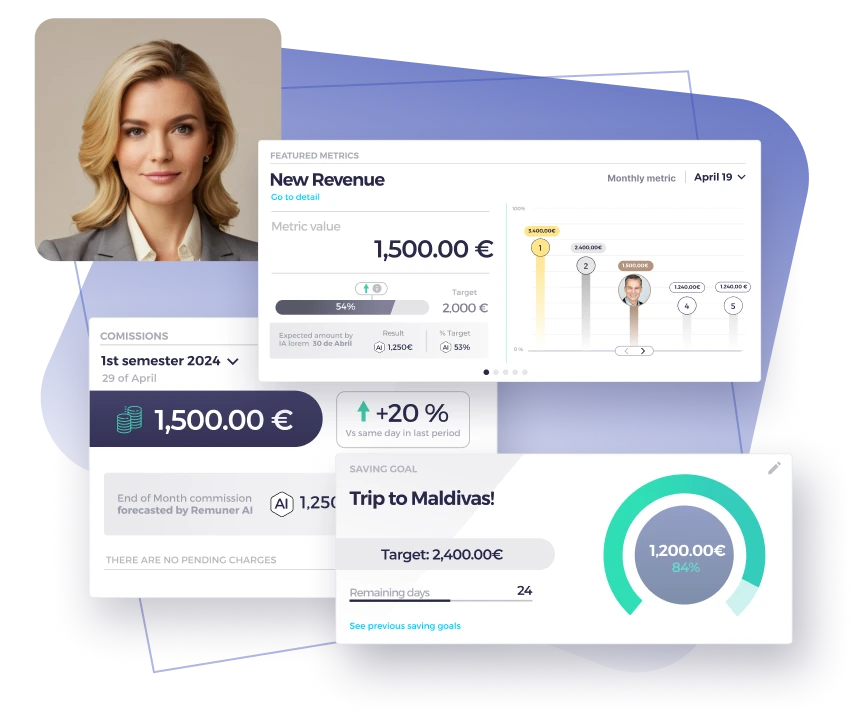Table of contents
What is sales productivity?
Sales productivity refers to how efficiently a sales team turns their efforts into revenue. It’s a measure of both the quantity and quality of a salesperson’s work. High productivity means closing more deals with less wasted time and effort.
The basic formula is:
Sales Productivity = Output / Input
Where:
- Output includes metrics like revenue generated, deals closed, or pipeline growth
- Input reflects time spent, number of touchpoints, and internal resources used
Optimizing productivity means improving the outcome without proportionally increasing effort.
Why sales productivity is essential
In high-growth environments, sales productivity determines how quickly and sustainably a company can scale. It impacts hiring efficiency, customer acquisition cost, and overall profitability.
As highlighted in McKinsey’s research on the future of B2B sales, hybrid selling—combining digital and human-led strategies—is becoming a key driver of productivity. Optimizing workflows ensures teams adapt to evolving buyer expectations while maximizing revenue.
Improving productivity helps:
- Increase revenue without expanding the sales team
- Shorten the sales cycle
- Strengthen conversion rates at each stage of the sales pipeline
- Enhance morale by rewarding results over activity
- Provide better forecasting and performance visibility
In today’s competitive market, productivity isn’t optional—it’s a differentiator.
Common obstacles to sales productivity
Many sales teams unknowingly introduce inefficiencies into their processes. Many of these challenges arise from outdated tools, unclear goals, or long-standing practices that no longer align with how the team operates today.
Common issues include:
- Time-consuming administrative tasks such as manual data entry or approval workflows
- Lack of clarity in commission structures or On-Target Earnings (OTE)
- Overly complex sales compensation plans
- Limited visibility into real-time sales performance
- Fragmented handoffs between departments
- Inconsistent coaching and feedback loops
Identifying and addressing these issues is the first step toward boosting sales productivity.
Remuner supports productivity by automating compensation tracking and simplifying commission structures, which reduces administrative tasks and gives sales teams real-time visibility into their earnings.
8 effective strategies to improve sales productivity
1. Automate administrative and repetitive tasks
Sales professionals often spend more time on non-revenue activities than on actual selling. Scheduling, CRM updates, compensation tracking, and reporting can consume a disproportionate amount of their time.
Automating tasks such as meeting scheduling, follow-up emails, CRM record maintenance and commission calculations can significantly increase time available for customer engagement.
Remuner’s impact: With Remuner’s compensation automation, teams eliminate manual calculations and reduce time spent resolving disputes over payouts.
2. Simplify your sales compensation plan
Compensation drives behavior. However, if sales representatives don’t understand how they are being compensated, motivation and trust suffer. A clear, transparent compensation plan aligns rep behavior with business objectives.
Key elements of a productive plan include:
- Well-defined OTE and base vs. variable pay
- Achievable quotas tailored to role and territory
- Clear, tiered commission models that incentivize top performance
- Visibility into earnings progress throughout the quarter
Overcomplicated plans with ambiguous conditions erode focus and create unnecessary confusion. Learn more about sales compensation plans here.
With Remuner: Managers can model, test, and implement flexible plans quickly. This helps drive the right outcomes while keeping teams aligned and informed: Learn more.
3. Adopt dedicated commission tracking software
Spreadsheets, while familiar, often lead to errors, disputes, and misaligned expectations. Sales commission software reduces administrative overhead, improves data accuracy, and supports real-time transparency for sales teams.
The advantages include:
- Centralized dashboards for earnings and quota progress
- Automation of multi-layered commission rules
- Scenario modeling for team performance planning
- Integration with CRM and financial systems
How Remuner supports this: With Remuner’s commission software, teams can gain real-time clarity into earnings, align incentives with targets, and build trust across departments.
4. Focus on metrics that matter
Not all metrics are created equal. While activity-based metrics (e.g., calls made) have their place, they often don’t reflect productivity. Sales leaders should focus on performance-oriented data points.
Examples of meaningful metrics include:
- Average sales cycle length
- Pipeline velocity
- Revenue per representative
- Quota attainment rate
- Conversion rates by funnel stage
- Time spent on selling vs. admin tasks
These metrics reveal bottlenecks and enable managers to coach more effectively.
5. Use targeted incentives to encourage desired behavior
Compensation plans often focus on quarterly or annual achievements. However, smaller, behavior-focused incentives can have an outsized impact when implemented thoughtfully.
For example:
- Daily performance recognition
- Bonuses tied to clean CRM data
- Spot rewards for specific behaviors (e.g., first meeting booked, cross-sell success)
These short-term incentives complement broader compensation structures and reinforce good habits.
6. Provide ongoing, personalized training
Sales training shouldn’t be a one-time event during onboarding. To remain competitive, teams must continuously refine their skills, stay current on products, and adapt to changing buyer behavior.
Effective training programs include:
- Role-specific skill development
- Real-time coaching based on call recordings or deal reviews
- Peer-to-peer learning sessions
- Microlearning and just-in-time content delivery
Training tied to real-time data and performance insights is far more effective than general workshops.
7. Strengthen collaboration between departments
Sales success depends not only on the sales team but also on alignment across marketing, customer success, finance, and operations.
Improving cross-functional collaboration reduces delays, improves lead quality, and ensures a smooth customer experience.
Actions that support alignment:
- Define shared metrics and service-level agreements
- Establish feedback loops between sales and marketing
- Collaborate on handoff processes and content needs
- Ensure compensation plans reinforce cross-departmental goals
Remuner’s role: With centralized dashboards and plan visibility, Remuner helps all stakeholders stay aligned on goals, quotas, and compensation expectations.
8. Use data to drive personalized coaching
One-on-one meetings should go beyond status updates. They should focus on performance improvement through coaching, goal setting, and accountability.
Data-based coaching is more objective, targeted, and actionable.
Effective coaching practices:
- Use pipeline health reports to focus on deal strategy
- Review performance against quota trends and conversion benchmarks
- Tailor sessions to each rep’s challenges and strengths
- Follow up on action plans regularly
By coaching smarter, managers can drive meaningful improvements without micromanagement.
Practical examples of improved sales productivity
Example 1: Shortening the sales cycle
A SaaS company identified that deals lingering past 30 days rarely closed. They realigned incentives, encouraging reps to close within 21 days. Supporting tools automated outreach for delayed prospects.
Outcome: The average sales cycle dropped by 20%, and win rates improved by 18%.
Example 2: Automating commission workflows
A fintech company struggled with month-end commission disputes due to manual spreadsheet errors. They adopted Remuner for real-time compensation tracking and introduced role-based dashboards.
Result: 80% reduction in administrative time and a complete elimination of payout-related conflicts.
Example 3: Increasing time spent selling
A B2B services firm conducted a time audit and found only one-third of time was client-facing. By automating calendar booking and pre-call research, and introducing small bonuses for sales activity hours, the share of selling time increased to over 50% in two months.
Technology’s role in modern sales productivity
Productivity today is inseparable from the tools that support and enable sales reps. A modern, integrated sales tech stack increases visibility, accelerates workflow, and enhances collaboration.
Essential technologies include:
| Tool Type | Function |
|---|---|
| CRM | Track customer interactions and manage pipeline |
| Sales engagement | Automate outreach, follow-ups, and cadences |
| Sales commission software | Automate incentive tracking and calculations |
| Enablement platforms | Deliver just-in-time training and content |
| Forecasting tools | Improve deal predictability and planning |
Remuner’s role: Remuner acts as a bridge between finance, sales, and leadership. It delivers compensation clarity and quota alignment through real-time dashboards, eliminating one of the most overlooked barriers to productivity.
Leadership’s role in sustaining productivity
Sustained improvement in sales productivity requires leadership commitment, not just tactical changes. Leaders set the tone for what matters, what gets rewarded, and how the team operates.
Effective leaders:
- Clarify goals and priorities
- Provide visibility into progress
- Address performance issues constructively
- Encourage knowledge sharing and experimentation
- Reinforce the connection between effort and reward
How Remuner supports leaders: With compensation insights and quota tracking, Remuner allows managers to coach with clarity and adapt plans to reflect current market dynamics.
Avoiding common mistakes
As organizations strive to increase productivity, they often fall into counterproductive patterns. Some of the most common include:
- Over-reliance on activity metrics instead of performance outcomes
- Designing overly complex compensation structures that confuse reps
- Failing to adapt to changing customer behavior
- Ignoring the impact of admin burden on rep morale
- Delaying payout approvals, leading to demotivation
By addressing these issues directly, sales leaders can create a healthier, more productive sales environment.
Assessing your sales team’s productivity
Consider the following questions as a self-assessment framework:
- Are your sales representatives clear on how they earn commissions?
- How much of their time is spent actively selling versus doing admin work?
- Are you using metrics that reflect true performance?
- Is your compensation plan motivating the right behaviors?
- Are you using technology to support—not burden—your team?
If gaps exist in any of these areas, it may be time to rethink your strategy.
Explore how Remuner can help: Whether you want to reduce disputes, model better plans, or increase performance visibility, Remuner offers a flexible platform designed to support growth-oriented sales teams.
Conclusion: A strategic approach to sales productivity
Improving sales productivity doesn’t require a complete overhaul of your team or processes. It requires alignment—between goals, incentives, tools, and behavior.
When organizations prioritize clarity, automation, and outcome-based coaching, they see measurable improvements not only in revenue, but also in engagement and retention.
Sales productivity is not a one-time initiative. It is a continuous cycle of analysis, adjustment, and execution. With the right systems in place, including a modern compensation platform like Remuner, organizations can unlock consistent and scalable performance gains.
FAQs about Sales Productivity
What is sales productivity?
Sales productivity refers to how efficiently a sales team or representative converts time and effort into revenue. It combines output (like deals closed or revenue) with input (time, energy, and resources used).
How can I measure sales productivity?
You can measure sales productivity using:
- Revenue per rep
- Quota attainment
- Sales cycle length
- Time spent selling vs. admin
- Conversion rates at each stage of the pipeline
What strategies improve sales productivity?
Effective strategies include automating repetitive tasks, simplifying compensation plans, aligning quotas with territory realities, providing personalized coaching and streamlining cross-functional collaboration.
How does sales compensation software increase productivity?
Sales commission software improves productivity by reducing manual work and errors, providing real-time insights into earnings, enabling scenario modeling for managers and accelerating payout approvals.
What’s the difference between sales productivity and efficiency?
Productivity measures how much output is generated relative to input. Efficiency refers to minimizing waste in achieving that output. Both are essential, but productivity often serves as the leading indicator of sales performance.





